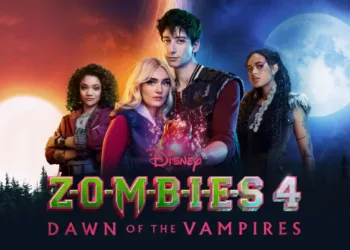A single, careless click of a button. In the age of digital immediacy, this is all it takes to ignite a firestorm. Netflix’s documentary Trainwreck: The Real Project X chronicles such an event, where a modern misstep led to almost primitive chaos. The film transports us to Haren, a placid and prosperous Dutch town, the kind of setting that seems immune to disorder.
Its central figure is Merthe Weusthuis, a teenager planning her 16th birthday. Her simple mistake was making the party’s Facebook invitation ‘public’. This documentary dissects how that innocuous decision became the seed for a full-blown riot, a story that plays out like a grimly fascinating social experiment.
The narrative skillfully builds a sense of dread, showing how a personal celebration was twisted into a public spectacle that would require riot police to contain. It stands as a potent parable, not just about social media, but about the fragility of social order in the face of a new, digitally-mobilized hive mind.
From Birthday Wish to Viral Blueprint
The initial escalation unfolds with the bewildering speed of a viral video. Merthe’s innocent plan for a gathering of friends is immediately lost as the public invitation is discovered. The film effectively uses screen recordings and animated graphics to visualize the spread, creating a palpable sense of digital anxiety.
The cultural context of 2012 is crucial; the lines of online etiquette were still being drawn. This void was filled by a recent Hollywood export, the film Project X, which became more than an inspiration—it provided a pre-packaged script for mayhem, a fantasy of American-style suburban rebellion that proved irresistible. This speaks volumes about the power of Hollywood as a global cultural exporter.
The invitation is quickly co-opted, with copycat pages titled “Project X Haren” amplifying the call to arms after Merthe deletes the original. This contrasts sharply with youth-centric narratives in Indian cinema, where rebellion is often rooted in a tangible cause like forbidden love or political awakening, as in Rang De Basanti.
Here, the rebellion is apolitical and detached; the goal is not social change but social currency, the desire to consume a cinematic experience. Merthe becomes a bystander to her own event, and the film captures her journey from amusement to sheer panic, a potent illustration of a modern loss of agency.
An Official Failure and a Night of Chaos
The film’s focus then shifts to the institutional response, revealing a failure of governance that feels both specific to this event and universally recognizable. The narrative presents a sharp contrast between two official mindsets. On one side is Groningen’s “Night Mayor,” a figure attuned to youth culture who sees the looming disaster and proposes a managed, alternative party to divert the masses.
On the other is Haren’s “Day Mayor,” Rob Bats, a politician who embodies an institutional arrogance, dismissing the threat as teenage hype. His failure is not just a lack of foresight but a refusal to listen, a classic theme found in political satires from Jaane Bhi Do Yaaro to the present. This breakdown is magnified by the film’s masterful use of archival footage.
The chaotic, shaky-cam visuals of the riot—looted stores, burning cars, violent clashes—convey a genuine sense of unpredictability. Unlike the choreographed action of a commercial film with a clear hero, this footage presents an amorphous, leaderless antagonist: the mob itself.
The sound design complements this, layering shouts, sirens, and breaking glass into an immersive and unsettling soundscape that plunges the viewer directly into the heart of the chaos on the streets of Haren.
A Spectacle Without A Soul
In the wake of the destruction, the documentary charts the fallout. Merthe, publicly shamed, felt compelled to leave her town, while Mayor Rob Bats faced the political consequences and resigned. The use of YouTube footage uploaded by aspiring influencers to identify and arrest perpetrators adds a layer of digital-age irony, a point the film acknowledges but doesn’t deeply explore.
It fails to question the ethics of those who profited from documenting the mayhem. While it effectively recounts the shocking events, its analysis is deliberately shallow. The film had an opportunity to be a profound look at a generation’s relationship with technology, community, and rebellion.
Instead, it opts for the sensationalist style of its parent Trainwreck series, choosing spectacle over substance. Its approach stands in stark contrast to the work of documentarians like India’s Anand Patwardhan, whose films are deeply researched, politically charged investigations of social phenomena.
The Real Project X packages a complex socio-technical event into a simple “crazy things happened” story, leaving the viewer entertained but not enlightened. It presents a compelling narrative but sacrifices a deeper authenticity for a product that is easily consumed.
Trainwreck: The Real Project X is a documentary film that premiered on Netflix on July 8, 2025.
Full Credits
Director: Alex Wood
Producers: BBH Entertainment, RAW
Executive Producers: Sheun Adelasoye De Nicola, Alexander Marengo, Tim Wardle, Casey Feldman, Erica Roberts, William Swann
Cast: Merthe Marije Weusthuis
Director of Photography (Cinematographer): Jean-Louis Schuller
Editors: Livia Serpa
The Review
Trainwreck: The Real Project X
Trainwreck: The Real Project X delivers a fascinating and briskly-paced account of a uniquely modern disaster. It succeeds as a shocking spectacle, effectively using its footage to create a sense of spiraling chaos. However, it prioritizes a sensational narrative over any meaningful inquiry into the cultural and technological forces at play. The result is a compelling story that informs you of what happened but leaves you wanting a much deeper understanding of why. It’s an engaging watch that sadly remains on the surface of its own profound subject matter.
PROS
- A gripping, almost unbelievable true story.
- Fast-paced editing that maintains tension.
- Effective use of archival and user-generated footage.
- A clear and potent cautionary tale about online actions.
CONS
- Lacks deep analysis or social commentary.
- A superficial approach that avoids complex questions.
- The sensationalist tone can feel exploitative.
- A missed opportunity to explore its subject with more depth.


















































